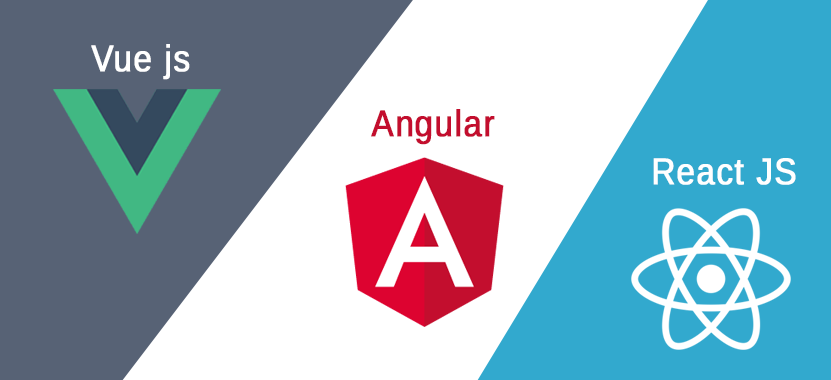Nowadays, Angular, React and Vue are three most popular and commonly used front end Javascript frameworks with their own set of characteristics. Developers and businesses starting on a software application development project may face difficulty in choosing the most suitable framework among them.
By throwing light on various aspects of these frameworks, this article acts as a guide for them and makes it easy for them to pick the most appropriate framework for their project in 2020.
Let’s begin by sharing the history of Angular, React and Vue frameworks:
Angular

Angular was developed by Google, the famous search engine service provider. It was released in 2010, thus making it the oldest of the three. This JavaScript framework is based on TypeScript. It was originally known as AngularJS, but in 2016 when Angular 2 was released, JS was dropped from its name. Angular 2+ is now simply known as Angular. Its latest stable version is Angular 7 which was released in October 2018.
Vue

Vue Javascript framework was developed by Evan You, a Chinese American and former employee of Google. Also known as Vue.js, it was released in 2014, thus making it the youngest of the three frameworks.
Over the last two years, the popularity of Vue has risen substantially. This is commendable keeping in view that it is not backed by a large company. Its current stable version is 2.17, which was released in August 2018. Vue 3.0, the upcoming new major version of Vue is currently in the prototyping phase and it is leaving JavaScript and moving to TypeScript.
Contributors to Vue are supported by Patreon, an emerging crowdfunding platform.
React

Facebook developed React and its initial release took place in 2013. The social media giant’s motive behind building React was to render web UI components fast and efficiently.
Facebook has extensively used React in its products like Facebook, Instagram and WhatsApp. 16.X is the current stable version of React, which was released in November 2018.
License
Before using an open-source framework, it is important for users to go through its license.
The common similarity in Angular, Vue and React is that they all use the MIT license, which places limited restrictions on reuse, even in proprietary software. Before using these frameworks or any other softwares, don’t forget to go through their license so as to be aware of the implications involved.
Popularity
A good way to judge the popularity of Angular, React and Vue is to check the number of stars they have received in their GitHub repositories.
On 12/17/2018, Facebook/React, Vuejs/Vue, Angular/Angular and Angular/Angular.js had received 117687, 122284, 43546 and 59311 stars respectively. Vue registered a sudden sharp increase in the number of stars in the middle of 2016 and recently. The above figures clearly show that Vue is ranked on top in terms of popularity, closely followed by React while Angular is way behind.
Job Market
An analysis was performed of the job market trends in late 2018 which took into consideration job figures associated with major job boards like LinkedIn, Indeed, SimplyHired, Dice, AngelList, Hired and Remote.
The findings of this analysis revealed that the number of jobs that required the skill set of Angular or React was approximately the same and captured the major segment of the job market while the number of jobs requiring the skill set of Vue was abysmally low at around 20%.
Looking at the current job market, it will be rewarding for developers to opt for learning Angular or React. But in view of the surge in the popularity of Vue over the last two years, it is simply a matter of some more time before existing or new projects start adopting Vue, leading to the requirement of an increased number of developers.
Community and Development
Before adopting a particular framework for their work, developers need assurance that there is an active community constantly working to fix issues, bringing improvements in it and developing it further.
Let’s now look at the community behind Angular, React and Vue frameworks to assess their development.
All these frameworks have come up with a major release in the last four months, which makes it evident that their development is going on vigorously.
The statistics of GitHub repositories of these frameworks will help you gain a better understanding of the extent of development activity taking place in them. The number of watchers, stars, forks, commits in the last month and contributors associated with Angular were 3.3k, 43k, 11k, 446 and 798 respectively.
The number of watchers, stars, forks, commits in the last month and contributors related to React were 3.7k, 71k, 16k, 339 and 1.8k respectively.
The number of watchers, stars, forks, commits in the last month and contributors associated with Vue were 5.7k, 122k, 17k, 81 and 240 respectively.
After analyzing the figures above, it becomes evident that Vue has a huge number of watchers, stars and forks. This shows it is more popular and has more value in comparison to React. But Vue has a less number of commits and contributors when compared to Angular and React.
One reason behind this can be the development of Vue is being entirely performed by the open-source community, but in the case of Angular and React, Google and Facebook employees have made noteworthy contributions to them.
These statistics make it clear that all three frameworks are undergoing a fair amount of development activity and their development will definitely continue in the coming time. So developers can use any of them without worrying about the lack of support, resolution of issues and improvement.
Migrations
While working with their chosen framework, developers have a fear that installing its new update may throw their code into disarray. Though in the majority of cases, they won’t face many issues at the time of transitioning from one framework version to another. Still, they should be aware of the updates as some of them can be more important and require fine adjustments to be made to them for keeping things compatible.
Angular comes with major updates in every six months. It also provides another six months for disapproving any major APIs. This gives developers the time of two release cycles spanning one year, which is enough for making any required changes.
When comparing Angular with React, Facebook accords absolute importance to stability, as large companies like Airbnb and Twitter make use of React. Upgrades take place through versions in React and they are usually the easiest. They contain scripts like react-codemod which help developers to migrate.
In Vue, 90% of Application Programming Interfaces are the same if users are performing the migration from 1.x to 2. A migration helper tool is available which works on the console for assessing the app status.
Size
The size of libraries of Angular, React and Vue is 500+ KB, 100 KB and 80 KB respectively.
Though there is a great difference between the sizes of these frameworks, still they are small in comparison to the average webpage size of 2+ MB in 2018.
Angular is suitable for building heavyweight applications, while React and Vue are fit for the development of lightweight applications.
Components
Whether it is Vue, React or Angular, components are essential parts in all these three frameworks. A component usually receives input and its behavior undergoes a change according to the input. This changed behavior is normally exhibited as a change in the user interface of some part of the page. The use of components facilitates code reuse. A cart on an e-commerce website or a login box on a social network are some good examples of components.
Angular
In Angular, components are known as directives. Directives are simply markers on document object model (DOM) elements. Angular can track the directives as well as attach a particular behavior to them. For that reason, the Angular framework separates the user interface part of components as HTML tag attributes and behaviors of components in the form of JavaScript code. This characteristic of Angular makes it different from React.
React
React combines the user interface and behavior of components. In this framework, the same part of the code is responsible for the creation of a UI element and dictating its behavior.
Vue
In Vue, user interface and behavior are also a part of components, which makes it more intuitive than React. Also, Vue can be highly customized, that allows developers to combine the user interface and behavior of components from within a script. Additionally, they can also use pre-processors rather than CSS, which is a useful functionality. Vue framework integrates well with other libraries such as Bootstrap. Level of Difficulty in Learning
Angular
Learning Angular is quite difficult as it is a complete solution. For mastering this framework, developers need to learn related concepts like TypeScript and MVC. For learning Angular, developers need to devote months. But this time is worth investing as they are able to understand how the front end works.
React
For new users, React provides a Getting Started guide. With its help, they can set up React in about an hour. Stack Overflow contains thorough and complete documentation on React along with solutions for common issues. React is not a full framework and its advanced features require using third-party libraries. For this reason, learning React is not that difficult, but it does depend on the path a user takes with added functionality.
Vue
Due to higher customizability, Vue is easier to learn than learning Angular or React. Apart from that, Vue overlaps with Angular and React in terms of their functionality like the use of components. For this reason, transitioning to Vue from Angular or React is easy. Simplicity and flexibility of Vue can be both advantageous and disadvantageous, as the framework allows poor code, which is difficult to debug and test.
Though learning Angular, React and Vue requires significant time and effort on the part of developers, they can use them in a limitless number of ways after they have attained mastery in them.
Here is a recap of the characteristic features of Angular, React and Vue frameworks.
Angular
- Released in 2010, most mature of the three frameworks
- Has received good backing from contributors
- Complete package
- Steep learning curve and concepts of development may prevent new developers from learning it
- Ideal for companies with big teams and developers who are already familiar with using TypeScript
- Google and Wix are major companies using Angular
React
- Released in 2013, old enough to be mature
- Received a huge number of contributions from the community
- Gaining extensive acceptance
- The job market for React is quite good and the framework has a bright future
- Good choice for users starting with front-end JavaSCript frameworks
- Seamless integration with other frameworks makes React beneficial for startups and developers who want some flexibility in their code
- Facebook, Instagram, WhatsApp, Glassdoor, PayPal and BBC are some of the popular companies using React
Vue
- Released in 2014, Vue is the youngest of three frameworks
- Is not backed by a major company
- Performed quite well in the last few years and has become a strong competitor to Angular and React
- Good choice for users who want simplicity and flexibility
- Developers and businesses should be cautious adopting Vue as it is not known how it will do in the future
- Established Chinese multinational companies like Alibaba and Baidu are using Vue as their primary front-end JavaScript framework
We hope this meticulous comparison of various aspects and characteristics of Angular, React and Vue; the three most popular JavaScript frameworks helps you choose the best option for your software application development project.
As each of these frameworks has its own share of benefits and disadvantages, we advise you to perform a critical analysis of your project’s and individual requirements yourself before deciding in favor of any one of them.
Meanwhile, if you are keen to hire developers having expertise in most commonly used front-end JavaScript frameworks like Angular and React for your project, you should approach a reputable web development company in India like Matrid Technologies.







Leave A Comment